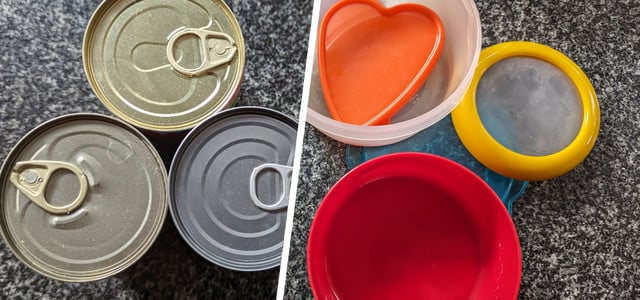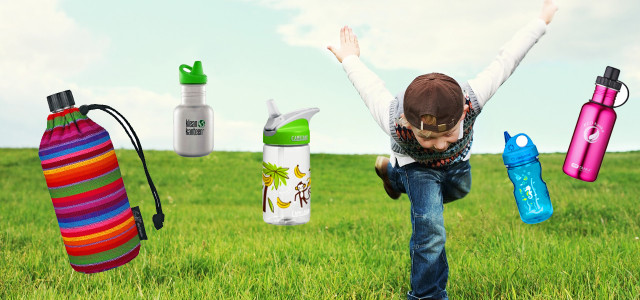
We still encounter the risky chemical bisphenol A (BPA) in many everyday objects and also food, as tests by Stiftung Warentest and Öko-Test show. Studies indicate that the chemical could be dangerous in much smaller quantities than previously thought. Utopia explains what you should look out for and how to avoid BPA.
Bisphenol A (BPA) is one of the chemicals that is very difficult to completely avoid in everyday life: It can be found in lunch boxes, kettles, drinking bottles and kitchen bowls, for example. But also in cans.
Stiftung Warentest tested 58 canned foods for bisphenol A – namely coconut milk, condensed milk, peas and carrots, tomatoes, stews, soups and tuna. They were able to detect the chemical in 51 foods.
The test of peeled tomatoes by Öko-Test (July 2023) also shows BPA levels in 18 canned tomatoes examined, which Öko-Test rates as “strongly increased”:
Bisphenol A: Limit value reduced by a factor of 20,000
For a long time, not much was heard about bisphenol A after the production of polycarbonate baby bottles containing BPA was banned in 2011 and the ban was extended to drinking bottles and containers for babies and children in 2018 – until last year. Since April 2023, there has been a new assessment by the European Food Safety Authority (EFSA).
The result: Based on current studies, EFSA concluded that BPA can be dangerous to humans in much smaller quantities than previously thought. In April 2023, it published a new assessment and lowered the value for the tolerable daily intake (TDI) of BPA set in its previous assessment (2015). Significantly: by a factor of 20,000.
The TDI value is the amount of bisphenol A that can be ingested daily over the course of a lifetime without posing a significant health risk.
- EFSA recommendation from 2015: 4 micrograms per kilogram of body weight per day
- EFSA recommendation from 2023: 0.2 nanograms per kilogram of body weight per day
This means that the TDI value is now about 20,000 times lower than before.
According to EFSA, 800 new studies were taken into account for the reassessment.
In Germany, the Federal Institute for Risk Assessment (BfR) is responsible for assessing contaminants from food packaging. In contrast to the EFSA, the BfR proposes a higher TDI of 0.2 micrograms per kilogram of body weight per day. According to the BfR, there is a lack of current data on the level of BPA exposure in the population.
Which value should be used as a guide in the future? For the testers at Öko-Test, the answer is clear: “Öko-Test is based on the EFSA’s TDI. The value is also based on concrete scientific findings on the toxicological risk potential of the substance.” Stiftung Warentest also used this value as a guide.
What is bisphenol A anyway?
Bisphenol A (BPA) is a chemical used in the manufacture of polycarbonate plastic and epoxy resins. These resins are used for the inner coating of beverage and food cans. The industrial chemical is one of the most widely used synthetic chemicals in the world.
The problem with bisphenol A is that it is released from packaging into food and is released from plastics when heated and warmed, thus ending up in our food.
How dangerous is BPA?
BPA is considered a type of hormone pollutant because it has an estrogen-like effect and alters hormone levels. The European Chemicals Agency has identified bisphenol as a “substance of very high concern with hormone-disrupting properties” because of its hormone-like effects.
BPA is particularly dangerous during sensitive phases of life, such as pregnancy. The effects of BPA are associated with developmental disorders in girls and boys (precocious maturity), with behavioral disorders in children, but also with a reduced sperm count, impotence and infertility. BPA is also suspected of promoting breast cancer and obesity and of having a negative effect on the immune system.
Where can bisphenol A be found?
Bisphenol A is found in many everyday products, for example:
-
Plastic items such as packaging, plastic tableware, drinking bottles and toys
-
Drinks and canned food cans (if they are coated with epoxy paint on the inside)
-
Food packaging (e.g. fast food)
-
Dental fillings (substances that can release bisphenol A during or after dental treatment are also used in the manufacture of plastic dental fillings and sealing compounds (= dental composites))
-
CDs, DVDs and Blu-rays
Good to know: Many products for babies and toddlers (eg pacifiers and baby bottles) are now BPA-free by law. BPA is also now banned in cash register receipts. However, many manufacturers have switched to bisphenol S (BPS) and bisphenol F (BPF). These bisphenols also have hormonal effects. It is therefore best to refuse (white) paper receipts when shopping. The blue receipts do not contain any of the bisphenols.

Non-industry-funded studies have found BPA in air, dust, surface water and sea water, but also in fruit from greenhouses and drinking water from plastic tanks. In humans, BPA is found in blood, urine, amniotic fluid and uterine tissue – all studies have found the highest levels in children.
How to avoid BPA: 10 tips
- It’s best to buy fresh food and avoid plastic packaging whenever possible. Here are 14 tips to avoid packaging in the supermarket.
-
Avoid canned food. According to a study by the CVUA (Stuttgart Chemical and Veterinary Investigation Office), coconut milk, meat, sausage, stews and ready meals are considered to be particularly contaminated. Stiftung Warentest was able to detect relatively high levels of BPA in soups and stews. If you buy canned food: transfer food from open cans into glass, ceramic or stainless steel containers.
- It is best to store food in glass, ceramic or stainless steel containers. Read our article: Living plastic-free: 12 amazing ideas for empty screw-top jars
-
Never heat food in plastic containers. If you absolutely have to store food in plastic containers, you should let it cool down first.
- When buying plastic containers, drinking bottles and plastic dishes, look for the label “BPA-free” or “BPA free”.
- When in contact with food, preference should be given to the “safer” plastics: polyethylene (abbreviated: PE) or polypropylene (abbreviated: PP).
-
Avoid polycarbonate: The plastic with the recycling code 7 (abbreviated: RE 7) often hides polycarbonate (abbreviated: PC), which contains bisphenol A.
- Before dental treatment, ask whether plastic fillings or sealants contain bisphenol A. Then ask about alternative materials.
- When preparing baby food: Never pour hot water into plastic bottles or heat baby food in plastic containers.
- It is better to avoid baby food in transparent, hard plastic containers where the type of plastic is not stated or which are marked “PC” (for polycarbonate).

You are on the safe side with glass bottles. Glass is the ideal packaging for food because it is impermeable and does not affect the product. This is why baby food is only sold in glass. Glass bottles with shatter-proof, protective casings are also available for transporting drinks.
Even uncoated drinking bottles and lunch boxes made of stainless steel are free of BPA and other harmful substances.
Avoiding bisphenol A is possible
The German Federation for the Environment and Nature Conservation (BUND) points out that it is certainly possible to do without BPA and that other countries are already further ahead in this regard: “Japan has been offering BPA-free canned goods for over 20 years. In France, bisphenol A has been banned in all materials that come into contact with food since 2015.”
Sources: Federal Environment Agency / Federal Institute for Risk Assessment (BfR) / BUND / Öko-Test
Read more on Techzle\.com:
- BPA-free coffee cups to go
- Plastic fasting: How to do without plastic step by step
- Plastic becomes sticky? What you should do now
** marked with ** or orange underlined Links to sources are partly affiliate links: If you buy here, you are actively supporting Techzle\.com, because we then receive a small part of the sales proceeds. .
You might also be interested in these articles
-
Polyamide (PA) simply explained: What you should know
-
Not just yoghurt: These things are also available in returnable glass jars
-
Black bin: What really has to or can go in the residual waste?
-
Plastic packaging for fruit and vegetables: no-go or necessary?
-
Plastic fasting: How to do without plastic step by step
-
“Simply reusable”: Reusable is much more than just the reusable bottle!
-
New packaging law: These are the current guidelines
-
Recycled material – the path to the circular economy
-
What is more sustainable: organic or unpackaged?